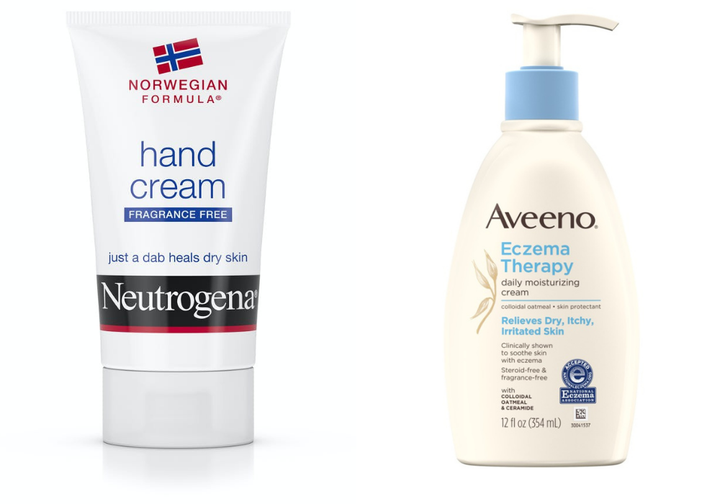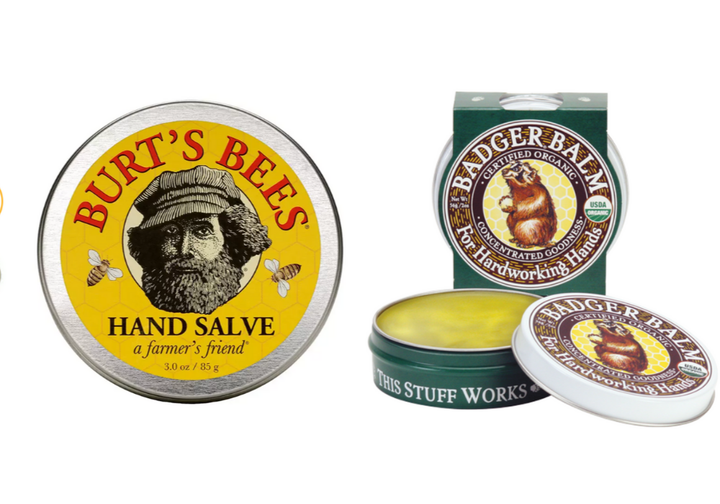
In the year since the coronavirus pandemic began, most of us have been washing our hands more than usual and obsessively using hand sanitizer. While those are important measures, they can lead to dry skin that cracks, flakes, itches and even bleeds, breaking down your skin’s protective barrier and putting you at greater risk of infection.
People who work with their hands ― woodworkers, artists, musicians and doctors, to name a few ― often experience these issues more severely than the rest of us, so they know a thing or two about the best products to keep hands moisturized and healthy.
The American Academy of Dermatologists recommends adding a moisturizing step to your hand hygiene routine, but if you need more help than that or if you work with your hands so much that you can’t afford to slather them with greasy moisturizer all day, there are other options for you. We spoke with several makers and artists who work with their hands all day, as well as four board-certified dermatologists, to find out their secrets.
For prevention, first moisturize, moisturize, moisturize. Then moisturize some more.
Youngmin Lee, a textile artist who creates works using the traditional Korean arts of bojagi (wrapping cloths) and mae dub (decorative knots), uses hand lotion with shea butter.
“I have tubes in many places in my house and constantly apply,” Lee said. She also keeps lotion on her bedside table so she doesn’t forget to put it on before going to sleep. “This isn’t a special way to take care of my hands, but keeping up a habit of applying frequently is key.”
Dermatologist Hope Mitchell (of Mitchell Dermatology) says her favorite moisturizing products are Soap & Glory’s Hand Food Cream and CeraVe’s Therapeutic Hand Cream.

Soap & Glory has a hydrating, non-greasy formula containing shea butter, glycerin, coconut, macadamia and grape seed oils, and dimethicone. “I highly recommend using this cream as many times during the day as you like and especially overnight for best results,” Mitchell said.
CeraVe, great for dry, cracked hands, contains ceramides that help restore and maintain the protective skin barrier. “It’s a perfect blend for hydration and sealing in moisture,” Mitchell told us.
Dermatologist Nazanin Saedi of the Jefferson Laser Surgery and Cosmetic Dermatology Center in Philadelphia, also loves CeraVe for its ceramides.
“There are many different products out there, and I feel like every skin care line now has a specific hand cream,” Saedi said, “but you want to look at the ingredients to see what those ingredients are actually doing.”
“As well as ceramide, which strengthens your skin barrier so that you’re losing less water, hyaluronic acid helps because it attracts and pulls water to your skin, keeping it hydrated,” she explained.
How to keep your hands healthy when you wash them frequently
Krista Steinberg of Looming Jane is a textile artist and weaver. “I’m constantly working with my hands; touching yarn, dyeing fibers,” she said. “When washing my hands, I have to wait for the water to be warm because too many cold washes contribute to the cracking,” Steinberg told us. Steinberg uses a thick balm from Trader Joe’s when she’s done working.
“Sometimes dehydration can play a part in my skin issues, so I make sure to drink as much water as I can to head that off. I can easily say I’ve never spent so much time caring for my skin as I have this winter!” she said.
Rajani Katta, a dermatologist at Baylor College of Medicine and McGovern Medical School in Houston, is prone to hand eczema, which makes her skin super dry. “If I’m not careful, I’ll start to get tiny cracks, so I make sure I use fragrance-free hand soap, and I carry hand cream in the pocket of my lab coat.”
She suggests not drying your hands completely after washing and applying the moisturizer when they are still a little damp.
Saedi keeps moisturizer in her lab coat pocket, too. “I like Neutrogena Norwegian hand cream,” she said, “because it’s not too slippery if you just put on a very small amount. At first it may feel a little greasy, but it absorbs quickly into the skin.”

What to do if you hate having greasy hands
Some hand creams are greasier than others, of course, which is something those who work with their hands need to keep in mind.
“If my hands are particularly sensitive when dry, I either treat them or do less things that will irritate them,” Steinberg said. “I’ll avoid ironing to prevent drying them further or I’ll wear gloves if I’m washing fiber out. If I use oil on my hands, I won’t work with fiber because of potential staining issues.”
“I like Aveeno Eczema Therapy cream,” Katta said. “If I put that on, I wait five or 10 minutes before I shake somebody’s hand.” Katta also recommends Neutrogena Norwegian formula hand cream, though she says she has to wait “a while before shaking someone’s hand after applying it.”
How to treat calluses and cracks in the skin
Iymaani Abdul-Hamid, a string musician and instructor at IAH Studio in the Bronx borough of New York City, says that playing stringed instruments naturally results in calluses. Many musicians like their calluses, as long as they don’t become painful.
“When it gets really dry, those calluses can crack or split. The harder we [musicians] pound our fingers down, the more likely we are to develop those cracks,” she said.
Abdul-Hamid makes her own moisturizer using 100% pure beeswax, calendula, comfrey with tea tree, jojoba, coconut and lavender oils. When she has a playing gig coming up, she makes extra sure to moisturize at night. As a musician, you can’t use anything that will make your hands too slippery while playing.

Maryellen Burdwood of SwiftHound Bows in Austin, Texas, constructs crossbows for museums, movies, TV shows, re-enactors and collectors. Her go-to hand care products are Burt’s Bees Hand Salve and Badger Balm.
“I use Neosporin (antibiotic cream) or Badger’s to treat any small scratches and keep them from getting infected in my not-pristine woodshop,” Burdwood said. “When I get slices from a bit of wood or metal, I use super glue to hold the skin together, prevent bleeding on my work, allow it to heal faster and to seal it to keep dirt and dust out.”
When asked about the super glue approach, Katta replied, “I might on occasion recommend this for deep cuts, but I’d use it sparingly as a suggestion. It would depend on how sensitive the person’s skin is and how deep the cut is.”
If you do develop cuts, you can seal them with a liquid bandage adhesive, Mitchell told us. “This will lock moisture in the skin and keep debris out. Consider moisturizing creams that contain ingredients such as ceramides, glycerin, shea butter and dimethicone,” she said.
For severe fissures, Katta recommends applying pure Vaseline petroleum jelly directly to the cracks.
Though many people might be tempted to use an antibiotic ointment on an open crack, Katta cautions against this because antibiotic ointments can sometimes trigger allergic reactions.
“They’ve done studies where they’ve tested pure petroleum jelly versus an antibiotic ointment and found that the rate of healing was the same,” she said.
“If hands develop calluses or very thick areas that are causing fissures (cracks) and will not heal with petrolatum, over-the-counter urea cream can be added to your nighttime regimen to help thin out the thick skin, which is what is contributing to the fissures,” said Carrie Kovarik, professor of dermatology at the Perelman School of Medicine.
Speaking of Vaseline…
All the dermatologists we spoke to recommended petrolatum, or petroleum jelly (which is what is in Vaseline), to care for severely dry and cracked hands.

“At night, put on a very thick coating of plain petrolatum all over the hands, around the fingers, under the nails, and don’t be stingy!” Kovarik told us. “Then wear a pair of plain white cotton gloves over your hands to bed. This will help the petrolatum heal your dry, cracked hands overnight. Do this as often as needed.”
Kovarik keeps zipper-seal bags with white cotton gloves in her office to give to patients because they work so well in combination with petrolatum.
“After a few days, the Vaseline makes a significant difference,” Saedi said. “Not only is it adding moisture, but it’s also creating a seal so that the moisture you do have in your skin isn’t leaving.”
A few final tips
As most everyone is aware, keeping your hands clean is one of the most important steps in preventing the spread of infection, COVID-19 or otherwise.
All four dermatologists pointed out that, whenever possible, it’s better to use soap and water than alcohol-based hand sanitizers since alcohol dries out your skin. They all suggest using a moisturizer after washing.
“We really already knew that increased handwashing and hand sanitizers would increase the risk of hand eczema, particularly in a patient with a predisposition to eczema/atopic dermatitis and in those that did it more often,” Kovarik said. With this in mind, Kovarik recommends sticking to mild, fragrance-free moisturizing soaps for sensitive skin.
“Do not overwash,” she said, “And keep a bland moisturizing cream with you to use after washing.”
As always, if you have skin issues that aren’t remedied by over-the-counter options, contact a board-certified dermatologist for further evaluation.
HuffPost may receive a share from purchases made via links on this page. Prices and availability subject to change.